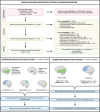Systematic review and meta-analysis of bulk RNAseq studies in human Alzheimer's disease brain tissue
- PMID: 40042520
- PMCID: PMC11881636
- DOI: 10.1002/alz.70025
Systematic review and meta-analysis of bulk RNAseq studies in human Alzheimer's disease brain tissue
Abstract
We systematically reviewed and meta-analyzed bulk RNA sequencing (RNAseq) studies comparing Alzheimer's disease (AD) patients to controls in human brain tissue. We searched PubMed, Web of Science, and Scopus for human brain bulk RNAseq studies, excluding re-analyses and studies limited to small RNAs or gene panels. We developed 10 criteria for quality assessment and performed a meta-analysis on three high-quality datasets. Of 3266 records, 24 qualified for the systematic review, and one study with three datasets qualified for the meta-analysis. The meta-analysis identified 571 differentially expressed genes (DEGs) in the temporal lobe and 189 in the frontal lobe, including CLU and GFAP. Pathway analysis suggested reactivation of developmental processes in the adult AD brain. Limited data availability constrained the meta-analysis. These findings underscore the need for rigorous methods in AD transcriptomic research to better identify transcriptomic changes and advance biomarker and therapeutic development. This review is registered in PROSPERO (CRD42023466522).
Highlights: Comprehensive review: Conducted the first systematic review and meta-analysis of bulk RNA sequencing (RNAseq) studies comparing Alzheimer's disease (AD) patients with non-demented controls using primary human brain tissue.
Key findings: Identified 571 differentially expressed genes (DEGs) in the temporal lobe and 189 in the frontal lobe of patients with AD, revealing potential therapeutic targets. Pathway discovery: Highlighted key overlapping pathways such as "tube morphogenesis" and "neuroactive ligand-receptor interaction" that may play critical roles in AD.
Quality assessment: Emphasized the importance of methodological rigor in transcriptomic studies, including quality assessment tools to guide future research in AD.
Study limitation: Acknowledged limited access to complete data tables and lack of diversity in existing datasets, which constrained some of the analysis.
Keywords: Alzheimer's disease (AD); RNA sequencing (RNAseq); differentially expressed genes (DEGs); human brain tissue; meta‐analysis; systematic review.
© 2025 The Author(s). Alzheimer's & Dementia published by Wiley Periodicals LLC on behalf of Alzheimer's Association.
Conflict of interest statement
The authors declare no conflicts of interest. Author disclosures are available in the Supporting Information.
Figures



Update of
-
Systematic review and meta-analysis of bulk RNAseq studies in human Alzheimer's disease brain tissue.bioRxiv [Preprint]. 2024 Nov 8:2024.11.07.622520. doi: 10.1101/2024.11.07.622520. bioRxiv. 2024. Update in: Alzheimers Dement. 2025 Mar;21(3):e70025. doi: 10.1002/alz.70025. PMID: 39574617 Free PMC article. Updated. Preprint.
References
-
- 2023 Alzheimer's disease facts and figures . 2023‐Alzheimer's & Dementia. Wiley Online Library. Accessed July 1, 2024. https://alz‐journals.onlinelibrary.wiley.com/doi/10.1002/alz.13016 - DOI
-
- Dementia . Accessed August 12, 2024. https://www.who.int/news‐room/fact‐sheets/detail/dementia
-
- Weller J, Budson A. Current understanding of Alzheimer's disease diagnosis and treatment. F1000Research. 2018;7:F1000 Faculty Rev‐1161. doi:10.12688/f1000research.14506.1 - DOI
Publication types
MeSH terms
Grants and funding
- A2020161S/BrightFocus Foundation
- P30AG072946/NH/NIH HHS/United States
- P30 AG072946/AG/NIA NIH HHS/United States
- 8AZ10/Ethel Moore Alzheimer's Disease Research Program
- 9AZ08/Ethel Moore Alzheimer's Disease Research Program
- Muscular Dystrophy Association
- RF1 AG082339/AG/NIA NIH HHS/United States
- R01 AG082730/AG/NIA NIH HHS/United States
- R35GM138636/NH/NIH HHS/United States
- R01AG082730/NH/NIH HHS/United States
- PhRMA Foundation: Predoctoral Drug Discovery Fellowship
- 2019-AARG44082/ALZ/Alzheimer's Association/United States
- RSGTMT17/PhRMA Foundation
- R01AG068331/NH/NIH HHS/United States
- R01 AG068331/AG/NIA NIH HHS/United States
- R35 GM138636/GM/NIGMS NIH HHS/United States
- RF1AG082339/NH/NIH HHS/United States
LinkOut - more resources
Full Text Sources
Medical
Research Materials
Miscellaneous

